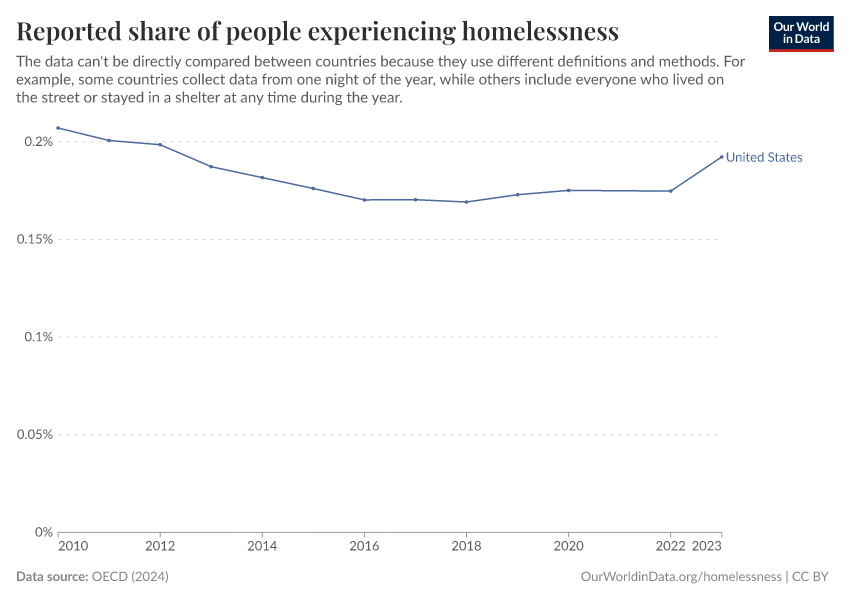Share of people experiencing homelessness

What you should know about this indicator
- Countries use different definitions and data collection methods and are harmonized to the extent possible.
- Data for the United Kingdom only considers England.
- Data for Ireland refers to October of each year.
- Data for the United Kingdom refers to households in Q2 (April-June) of each year.
- Data refers to point-in-time data (collected at one point in time), except for Austria, Latvia and Slovenia, which refers to flow data (collected at a given period of time).
- More details about definitions, methodology and comparability issues can be found in the OECD Population Experiencing Homelessness documentation.
- For more information on the statistical definitions for each country, please check the OECD's Country Notes on Homelessness data.
Related research and writing
What you should know about this indicator
- Countries use different definitions and data collection methods and are harmonized to the extent possible.
- Data for the United Kingdom only considers England.
- Data for Ireland refers to October of each year.
- Data for the United Kingdom refers to households in Q2 (April-June) of each year.
- Data refers to point-in-time data (collected at one point in time), except for Austria, Latvia and Slovenia, which refers to flow data (collected at a given period of time).
- More details about definitions, methodology and comparability issues can be found in the OECD Population Experiencing Homelessness documentation.
- For more information on the statistical definitions for each country, please check the OECD's Country Notes on Homelessness data.
Sources and processing
This data is based on the following sources
How we process data at Our World in Data
All data and visualizations on Our World in Data rely on data sourced from one or several original data providers. Preparing this original data involves several processing steps. Depending on the data, this can include standardizing country names and world region definitions, converting units, calculating derived indicators such as per capita measures, as well as adding or adapting metadata such as the name or the description given to an indicator.
At the link below you can find a detailed description of the structure of our data pipeline, including links to all the code used to prepare data across Our World in Data.
Reuse this work
- All data produced by third-party providers and made available by Our World in Data are subject to the license terms from the original providers. Our work would not be possible without the data providers we rely on, so we ask you to always cite them appropriately (see below). This is crucial to allow data providers to continue doing their work, enhancing, maintaining and updating valuable data.
- All data, visualizations, and code produced by Our World in Data are completely open access under the Creative Commons BY license. You have the permission to use, distribute, and reproduce these in any medium, provided the source and authors are credited.
Citations
How to cite this page
To cite this page overall, including any descriptions, FAQs or explanations of the data authored by Our World in Data, please use the following citation:
“Data Page: Share of people experiencing homelessness”, part of the following publication: Bastian Herre and Pablo Arriagada (2024) - “Homelessness”. Data adapted from OECD. Retrieved from https://archive.ourworldindata.org/20251023-195030/grapher/reported-share-of-people-experiencing-homelessness.html [online resource] (archived on October 23, 2025).How to cite this data
In-line citationIf you have limited space (e.g. in data visualizations), you can use this abbreviated in-line citation:
OECD (2024) – with minor processing by Our World in DataFull citation
OECD (2024) – with minor processing by Our World in Data. “Share of people experiencing homelessness” [dataset]. OECD, “OECD Affordable Housing Database (AHD)” [original data]. Retrieved December 28, 2025 from https://archive.ourworldindata.org/20251023-195030/grapher/reported-share-of-people-experiencing-homelessness.html (archived on October 23, 2025).